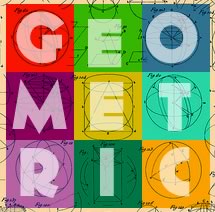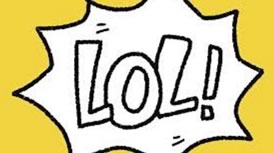
We don’t LOL as often as we used to, do we?
Five years ago, it felt like every second TXT, IM, or Facebook post would contain a lowercase LOL, if not a fully-fledged ‘ROFL‘.
A recent Facebook study claims over half of us use ‘Haha’ while ‘LOL’ usage has dropped to 1.9% of us. Poor LOL only made it into the OED in 2011 but its golden era has already passed.But in 2016, we seem to be all about the emoji.
- The cheeky wink
;-), - The incredulous stare,
:ಠ_ಠ - The single tear
:'( - The full ‘shruggy‘
¯\_(ツ)_/¯
We’ve all learned to hack the way the text interface works to communicate messages that words alone can’t. Your mother probably does it. Maybe your kids or nephews and nieces do too.
Sure, in theory typing the words ‘I’m winking at you‘ conveys the basic meaning but it’s somehow more formal AND more creepy at the same time. A ;) is both less and more.
So, on some level, we’re all UI hackers. But we’re not the first generation to do this.
1840: When Mail was the Hot Social Platform
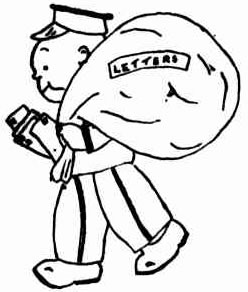
It’s probably hard for us to appreciate what a tech miracle the postal service was to anyone living in the mid-1800’s. While royalty and governments had run their own messaging networks for centuries, these systems had always been expensive, unreliable and difficult to comprehend. Postage rates were tied tightly to the mileage of each individual letter – like a taxi fare – except the receiver had to pay for delivery.
I imagine that email would have been far less attractive if we’d all had to pay a hefty fee for each Russian spammer or Nigerian prince spam we received. That was how all public mail services worked prior to 1840, so the idea that a working-class person could send a message anywhere in the country for a penny would have boggled minds!
Not surprisingly, the service was a roaring success, carrying huge volumes of mail by the 1850s at up to three deliveries a day.
Coded Messages of Love
Postal deliveries were a big event for any household – rich or poor – so it was practically impossible to get mail to someone without the entire household knowing about it. At a time when ‘Victorian morals’ were central and privacy wasn’t, this made personal, private messaging between couples very difficult.
So, how did they speak their feelings without writing it?
They coded it into the positioning of their stamps.
Apparently the ‘secret stamp code’ actually emerged back in the ‘receiver pays’ mail era as a way to dodge exorbitant postal fees. The sender could encode a simple answer into the placement of their stamp on the envelope – perhaps ‘yes’, ‘no’, or ‘come at once’. The receiver could then examine the envelope, extract the message and then refuse to pay the delivery fee for the unopened letter.
Obviously, this became redundant in the ‘penny post’ era but later couples adopted the system for their own needs. Here’s an example.
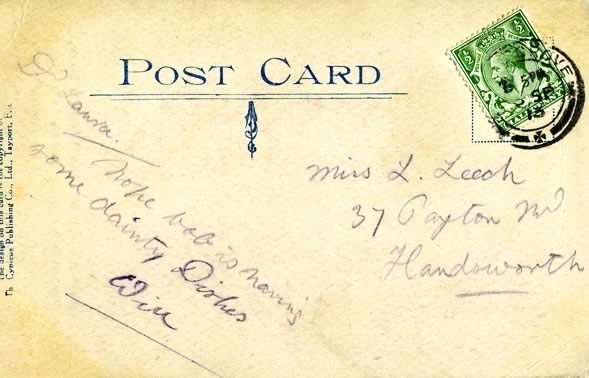
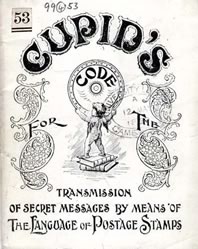
The postcard above appears perfectly innocent to anyone scanning it. Will is asking Laura if “Bob is having some dainty dishes“. A little oblique – perhaps an ‘in-joke’ – but nothing improper.
In reality, the stamp tells another story. Will was telling Laura: “I’m longing to see you“. I hope that Bob wasn’t Laura’s husband.
This stamp messaging system was used across the postal systems of the world although there was significant variation between countries. Some system relied on where the stamp was placed on the postcard while others were concerned only its orientation to the page.
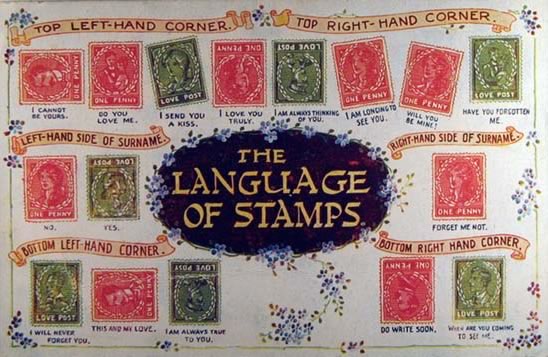
The system was remarkably subtle and sophisticated. Messages could be as simple as ‘Yes’ or ‘No’ but also as complex as:
- “May I ask for your portrait?”
- “Take care. We’re being watched.”
- “I think you are very ungrateful.”
- “My heart is another’s”
- “I have discovered your deceipt.”
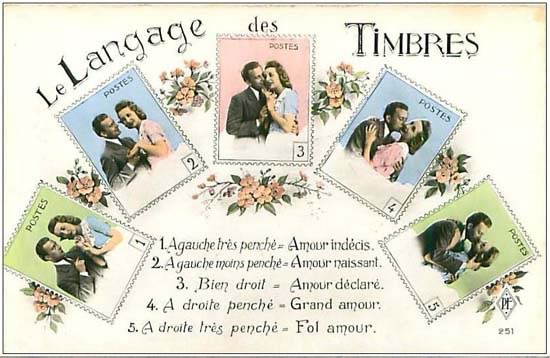
In fact, the introduction page in one ‘how-to’ booklet claimed to be able to encode 270,000 message variations. It makes you wonder if we really need the full alphabet anymore.
Of course, postcard companies often saw the code as a great opportunity to sell more postcards. They printed millions of these stamp messaging guides from the 1890s onward, though there was never a centralized body standardizing the code from region to region. Variation and mutation happen naturally.
As a consequence, some guides prescribe that a 90º right-turned stamp means a hopeful “Reply at once!“, while other guides would interpret the same stamp as “I wish for your friendship, but no more“.
I suspect there must have been thousands of star-crossed lovers who’s dreams were dashed by a misread coded message from a potential partner. Who would have thought that the mundane act of attaching a stamp to a letter could be loaded with such social danger?
You have to LOL, right?
Originally published in the SitePoint Design Newsletter.
Frequently Asked Questions (FAQs) about the Secret Coded Language of Postage Stamps
What is the secret coded language of postage stamps?
The secret coded language of postage stamps refers to the hidden messages that were conveyed through the placement and orientation of postage stamps on envelopes, particularly during the Victorian era. This coded language was often used as a form of secret communication between lovers, friends, and family members. The position of the stamp on the envelope could indicate a variety of sentiments, from love and affection to anger and rejection.
How did the coded language of postage stamps originate?
The coded language of postage stamps originated during the Victorian era, a time when societal norms and restrictions often limited open expressions of emotion. People began using the placement and orientation of postage stamps as a covert way to communicate their feelings. This practice became widespread, with different positions and orientations carrying specific meanings.
What are some examples of messages conveyed through the coded language of postage stamps?
There are numerous messages that could be conveyed through the coded language of postage stamps. For instance, a stamp placed upside down in the top left corner of an envelope could indicate that the sender loves the recipient. A stamp placed at a right angle in the top right corner could mean that the sender is not free to express their feelings openly. A stamp placed in the bottom left corner could signify that the sender wishes to be friends with the recipient.
Is the coded language of postage stamps still in use today?
While the coded language of postage stamps is not as widely used today as it was during the Victorian era, there are still individuals and groups who use it for fun or to keep the tradition alive. However, with the advent of digital communication, the practice has largely fallen out of use.
How can I learn more about the coded language of postage stamps?
There are numerous resources available for those interested in learning more about the coded language of postage stamps. Many philatelic societies and clubs offer information and resources on the subject. Additionally, there are books and online articles that delve into the history and meanings of the coded language.
Can the coded language of postage stamps be used with any type of stamp?
The coded language of postage stamps can theoretically be used with any type of stamp. However, it is traditionally associated with postage stamps, as these were the most commonly used stamps during the Victorian era when the practice originated.
Are there any rules or guidelines for using the coded language of postage stamps?
While there are no official rules or guidelines for using the coded language of postage stamps, there are traditional meanings associated with different stamp placements and orientations. These meanings were generally understood and adhered to by those who used the coded language.
What is the significance of the coded language of postage stamps in philately?
The coded language of postage stamps holds significant interest for philatelists, or stamp collectors. It adds an extra layer of intrigue and history to the hobby of stamp collecting. Understanding the coded language can also provide insights into the social and cultural norms of the time when the practice was in use.
Can the coded language of postage stamps be considered a form of art?
The coded language of postage stamps can indeed be considered a form of art. It involves creativity and imagination in the way stamps are placed and oriented to convey specific messages. Moreover, it reflects a unique form of non-verbal communication that has historical and cultural significance.
How can I start using the coded language of postage stamps?
If you’re interested in using the coded language of postage stamps, start by familiarizing yourself with the traditional meanings of different stamp placements and orientations. You can then begin experimenting with using the coded language in your own correspondence. Remember, it’s all in good fun and a way to keep a unique historical tradition alive.
 Alex Walker
Alex WalkerAlex has been doing cruel and unusual things to CSS since 2001. He is the lead front-end design and dev for SitePoint and one-time SitePoint's Design and UX editor with over 150+ newsletter written. Co-author of The Principles of Beautiful Web Design. Now Alex is involved in the planning, development, production, and marketing of a huge range of printed and online products and references. He has designed over 60+ of SitePoint's book covers.


